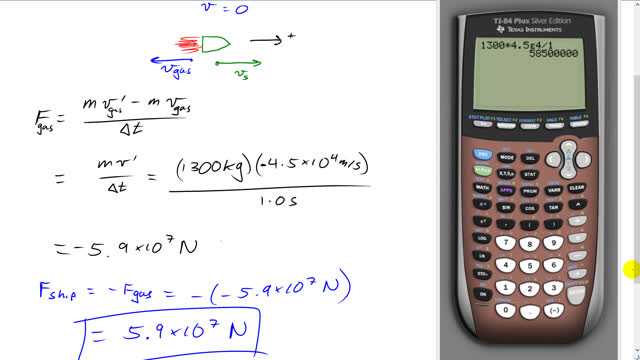
Calculate the force exerted on a rocket when the propelling gases are being expelled at a rate of 1300 kg/s with a speed of .

In order to watch this solution you need to have a subscription.
This is Giancoli Answers with Mr. Dychko. To find the force on this ship, we'll first figure out the force exerted on the gas because the ship and the gas force are both Newton's third law counterparts so the force that's exerted on the gas is equal to magnitude but opposite direction to the force exerted on the ship because they are exerting the force on each other. Okay. So we can calculate the force on the gas because we know everything about it to figure out its change in momentum versus change in time. So the amount of time that passes is gonna be 1 second because we are told that 1300 kilograms of gas is ejected from the back of the ship every second and so the mass is 1300, and the velocity of the gas, after it shoots out the back, is gonna be negative 4.5 times 10 to the 4 meters per second if we take to the right as being the positive direction; we'll take the directional velocity of the rocket to be positive so that's v s for ship, velocity of the ship is positive to the right, which makes the velocity of the gas to the left, negative. So when we find the force on the gas, we have change of momentum is the mass of the gas times its final velocity minus the mass of the gas times its initial velocity but it starts at rest inside the rocket in the rocket's gas tank so it has zero velocity to begin with and so we have just m v prime over t. So it's gonna be 1300 kilograms times negative 4.5 times 10 to the 4 meters per second divided by 1 second which makes negative 5.9 times 10 to the 7 newtons. Now the force on the ship is a negative of the force on the gas because of Newton's third law pairs and so that makes the final answer 5.9 times 10 to the 7 newtons is gonna be the force on the ship.
At 0:26, why can we analyze "the gas" as a body in and of itself if it is part of the rocket, would we not have to analyze the rocket as a whole (the mass of whom is not given)?